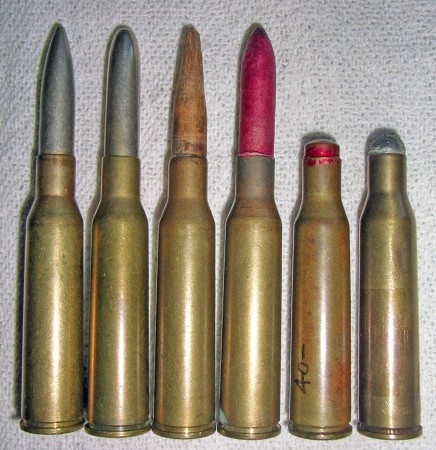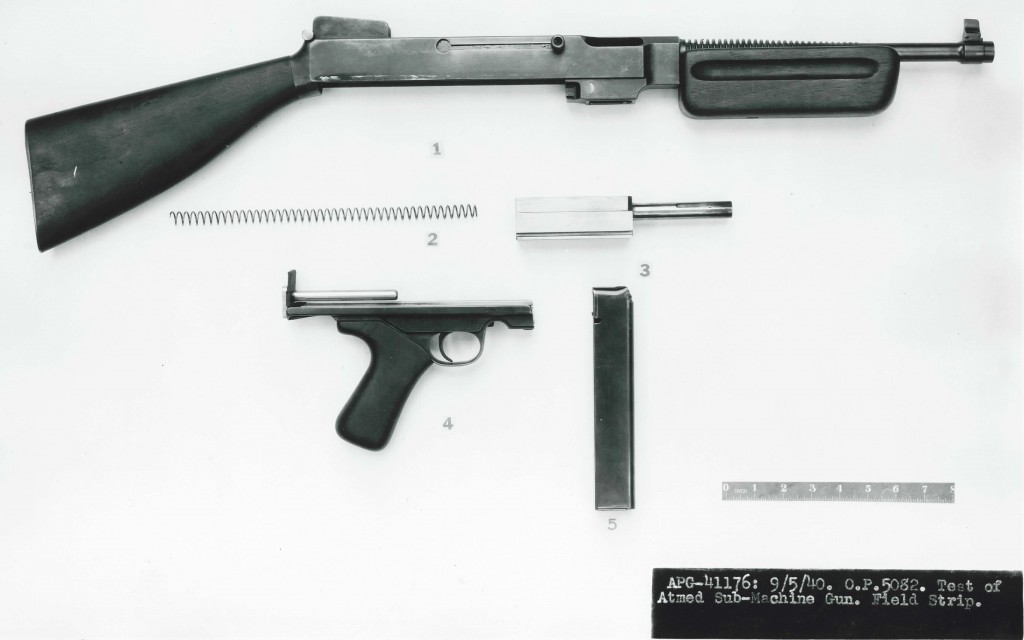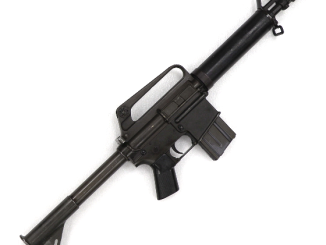First up today, we have some additional information on the scaled-down Arisaka trainer from our video on Monday. Teri from Nambu World gave us some more details (thanks, Teri and Chip!) that we would like to share. The rifles were actually made by the Nambu company, starting in 1927 and running into the early 1930s. Lt. Gen. Kijiro Nambu (the same man who developed the Nambu pistols and machine guns) started the company to make training rifles after his retirement from military service.The company was eventually bought up and merged with other firms and went into manufacture of more standard weaponry.
My assumption that the small-scale training rifle fired blanks was incorrect – Japanese blank cartridges for the 6.5mm were fitted with normal-size wooden bullets (for use with cut-type grenade launchers). The trainers actually used gallery rounds with very small and light projectiles. Presumably the recoil from these was light enough to safely use the bolt handle for locking. Courtesy of Teri, here’s a photo of the different types of 6.5mm Japanese ammunition:

The trainers used the two gallery cartridges on the right-hand end of the photo. In addition, there was apparently a conversion kit (extremely rare today) to make the trainers into air rifles firing small darts.
Atmed SMG
Our second piece for today is from our collection of Aberdeen Proving Grounds photos, and shows a field-stripped Atmed SMG, dated dated September 1940. We don’t have any other information on the gun, but it looks very reminiscent of a simplified Thompson, using a basic straight blowback action and firing from an open bolt. I believe it is covered at least briefly in Frank Iannamico’s book on American submachine guns, but I haven’t gotten my hands on a copy yet. When we have some more information, we’ll do a more detailed post – but for now, here’s Aberdeen’s field-stripped photo (click to enlarge):




Ian is the email notifications broken? I have not received any emails for over a week :S
I believe Google has decided I’m spam, and so email notifications to gmail accounts are being sent to your spam folder. I’m working on getting that fixed…
Yes, gmail decided you are spam 2 weeks ago. No matter how many times I click “not spam”, they do as they please.
Hi all.
According to F.W.A. Hobart, the Atmed was based on the Hyde Model 35 and was built by Hyde for the Atmed Manufacturing Company of New York. It had a 20 rnd magazine in .45 ACP. Tested with 750 rounds in September 1942 at Aberdeen Proving Grounds, it was the first such gun to pass the mud tests. Unfortunately, its fixed firing pin caused several pierced primers until shortened by 0.009 inches and the sear spring was weak, causing it to occasionally fire short bursts in semi-auto. Although it functioned well in mud and dust, there were too many niggles and it was not deemed worthy of development. Only one “tool-room batch” was produced.
Cheers,
MJ
The Atmed still sounds like an SMG with good developmental potential. The “bugs’ you mentioned are often typical of prototype and pre-production gun designs, so there is nothing significantly untoward in that area that could not be ironed out with some development. Too bad the exigencies of wartime and the internal politics involved prevented taking this gun any further.
This reminds me of the “unknown .30 carbine” in the shape of the grip frame and odd fishbelly buttstock.
I’m not very familiar with the Thompson – did all Thompsons have an open jaw to accept drum mags, or were some built with a receiver which was full depth around the mag?
@ Keith
Early Thompsons (all Blish-lock models, 1921 and 1928 plus 1928A1) were fitted with BOTH vertical channel for stick magazines (the XX, or 20-rd) and drum magazines (mostly the L or 50-rd, but early C-mags for 100 rds were also available) while the late Thompsons (blowbacks – the M1 and M1A1) retained only the vertical rail, and a new stick magazine, the XXX (30 rounders) were introduced to augment ammunition supply after drums were dropped.
correction: I lost the “horizontal rail for drum magazines” part from the early TSMG comment. It should read:
“Early Thompsons (all Blish-lock models, 1921 and 1928 plus 1928A1) were fitted with BOTH vertical channel for stick magazines (the XX, or 20-rd) and horizontal rail for drum magazines…”
Thanks Leszek,
Thompsons are really not one of my strong points.
Thanks for the update on the Arisaka trainer, Ian. Teri and Chip are an absolute treasure when it comes to the history of rare and not-so-rare Japanese firearms!
I totally appreciate your willingness to publish corrections and addenda. It’s one of the things that makes this site such a good resource.
Could somebody do a Photoshop job on the Atmed so we can see what it looks like assembled? Contrary to what jamezb said above, the grip resembles that of the Hyde Model 35: http://www.sturmgewehr.com/dalbert/Hyde_Left.jpg Do you have anything on the Model 35 for a post in the future, Ian?
Apologies for the gauchery of linking to my own blog, but that’s the only place I have in which to post a pic of the assembled Atmed. Pictured here with its family tree for comparison: http://mickimahoney.blogspot.co.uk/2013/05/atmed-smg.html.
Thanks a lot, Micki! I wonder how comfortable the length of pull is with that design. It looks to be longer than that of the Thompson. Though, it could be an optical illusion.
Just for the record, I have no objection whatsoever to you linking to other places – especially your own blog. Thanks for the picture!
OK, thanks Ian and you’re welcome Big Al.
Re: the Hyde 35, again, according to Hobart, the Hyde Mod. 35 was a minor modification of the Mod. 33 and tested at Aberdeen Proving Grounds in Oct./Nov. 1939. An open-bolt/blowback design in .45 ACP, the Mod. 35 had a 20-rnd magazine as standard but, interestingly, several of these could be brazed together, then moved laterally across when expended — rather like the later MP40/11.
During the tests at Aberdeen, the Hyde Mod. 35 performed better than the Thompson under adverse conditions, being simpler in design. It also handled better and had less recoil. Unfortunately, the cocking handle was at the back, (as you can see from the pictures,) and came back a half-inch towards the user’s eyes every time the thing recoiled. Needless to say, this was an unpopular feature and in later developments the cocking handle was moved to the side. Users also objected to the muzzle-flash and the weakly supported foregrip. The Mod. 35 was used as the basis of the ill-fated Hyde-Inland M2.
No data on the length of pull on the Atmed, unfortunately. Maybe because the magazine is further forward than both the Thompson and the Mod. 35, and the stock is mounted directly on the back, it gives the impression of length?
Cheers,
MM
So the later 6.5x50mmSR Arisaka cartridges used cupronickel bullets? I have a cartridge that appears to be one, and wikipedia led me to believe that it was from before 1905. But the image here makes me think it could indeed be from WW2, which would make sense since it was found among my grandfather’s possessions and he served in the Pacific theater.
Here are some pictures: http://imgur.com/a/0Aag2